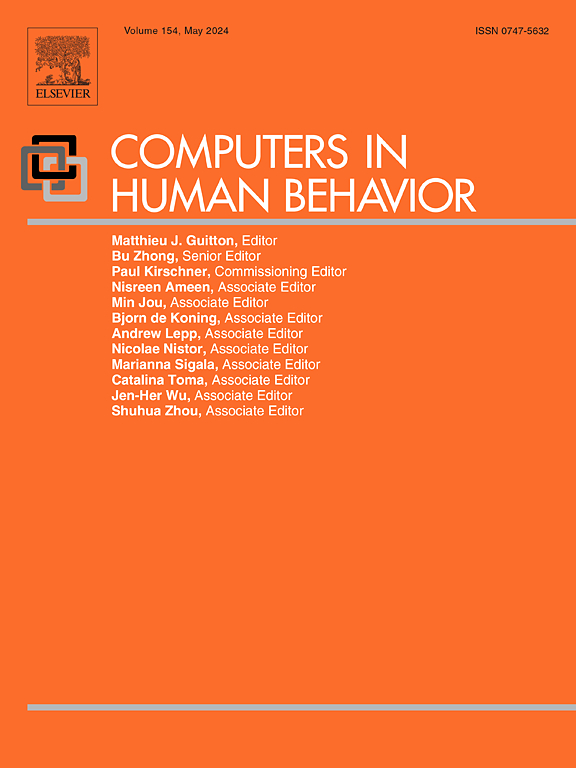儿童后期传统欺凌和网络欺凌中的旁观者行为:概况、发展路径及其与心理社会适应的关系
IF 8.9
1区 心理学
Q1 PSYCHOLOGY, EXPERIMENTAL
引用次数: 0
摘要
随着数字技术的快速发展,网络欺凌已成为全球儿童面临的重大挑战,与传统欺凌形成了复杂的生态系统。虽然旁观者在欺凌事件中占多数,并对其动态产生重大影响,但先前的研究在很大程度上是孤立地考察了他们,忽视了综合模式和纵向过渡。本研究采用三波纵向设计和随机截点潜在转变分析(RI-LTA)来确定儿童后期传统欺凌和网络欺凌情境下旁观者行为的特征和发展路径,并探讨其与心理社会适应的关系。发现了四种特征:持续的亲欺凌、持续的低防御、网络亲欺凌占主导地位和持续的防御。一贯的防卫型人格特征表现出最高的稳定性,并与良好的心理社会适应相关,而一贯的亲欺凌型人格特征则与最差的心理社会适应相关。网络亲霸凌主导型人格稳定性最低,转变为一致防卫型人格的可能性最高。令人惊讶的是,这一概况报告了更少的内化问题,更多的亲社会行为和更高的幸福感。此外,从适应不良的旁观者形象转变为一贯的防御形象的个体与社会心理适应的改善有关,而那些向相反方向转变的个体则表现出下降。这些发现强调了儿童晚期是旁观者干预的关键时期,并为综合欺凌预防策略提供了实证支持。本文章由计算机程序翻译,如有差异,请以英文原文为准。
Bystander behavior in traditional and cyberbullying in late childhood: Profiles, developmental paths, and their associations with psychosocial adjustment
With the rapid advancement of digital technology, cyberbullying has emerged as a significant challenge for children worldwide, forming a complex ecosystem with traditional bullying. Although bystanders constitute the majority in bullying incidents and critically influence their dynamics, prior research has largely examined them in isolation, overlooking integrated patterns and longitudinal transitions. This study utilized a three-wave longitudinal design and random intercept latent transition analysis (RI-LTA) to identify profiles and developmental paths of bystander behavior across traditional and cyberbullying contexts during late childhood and explored their associations with psychosocial adjustment. Four profiles were identified: consistent pro-bullying, consistent low defending, cyber pro-bullying dominant, and consistent defending. The consistent defending profile showed the highest stability and was associated with favorable psychosocial adjustment, whereas the consistent pro-bullying profile was associated with the poorest psychosocial adjustment. The cyber pro-bullying dominant profile exhibited the lowest stability and the highest likelihood of transitioning into the consistent defending profile. Surprisingly, this profile reported fewer internalizing problems, more prosocial behavior, and higher well-being. Moreover, individuals transitioning from maladaptive bystander profiles to the consistent defending profile was associated with improved psychosocial adjustment, whereas those shifting in the opposite direction exhibited declines. These findings highlight late childhood as a pivotal period for bystander-focused interventions and offer empirical support for integrated bullying prevention strategies.
求助全文
通过发布文献求助,成功后即可免费获取论文全文。
去求助
来源期刊

Computers in Human Behavior
Multiple-
CiteScore
19.10
自引率
4.00%
发文量
381
审稿时长
40 days
期刊介绍:
Computers in Human Behavior is a scholarly journal that explores the psychological aspects of computer use. It covers original theoretical works, research reports, literature reviews, and software and book reviews. The journal examines both the use of computers in psychology, psychiatry, and related fields, and the psychological impact of computer use on individuals, groups, and society. Articles discuss topics such as professional practice, training, research, human development, learning, cognition, personality, and social interactions. It focuses on human interactions with computers, considering the computer as a medium through which human behaviors are shaped and expressed. Professionals interested in the psychological aspects of computer use will find this journal valuable, even with limited knowledge of computers.
 求助内容:
求助内容: 应助结果提醒方式:
应助结果提醒方式:


